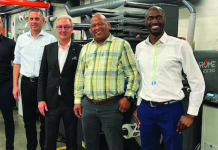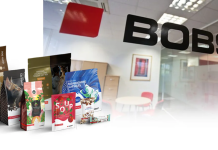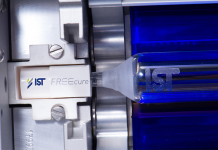Members of FINAT, the international trade association for self-adhesive labelling and related industries, convened in June in Monte Carlo for their 2014 annual congress, to address the core topic of ‘The Battle for Shelf Appeal’.
The label industry is no longer a separate and niche one in the field of packaging print. It has a new and extended profile as a provider of product decoration, brand identity, product data, smart phone interaction, track-and-trace and authentication data and packaging itself.
Congress Moderator Marc Büttgenbach (DE), worldwide sales director for Bizerba Labels and Consumables, introduced the keynote speaker, Rik Olthof (NL), brand strategist at international branding and packaging design consultancy Cartils.
Olthof explained the essence of branding, showing how important the look and feel of a product are to its ‘shelf appeal’. The key to success is to ensure product impact and visibility in a variety of different environments, from supermarkets (where, today, the consumer spends an average of just 20 minutes, making ‘shelf appeal’ essential for the purchasing decision) – to clubs and bars. Olthof identified a number of iconic names like Nike, Lamborghini, and Smirnoff, whose branding pathways are demonstrably successful.
There are five key pillars for successful brand identity. Shape, which conveys the character of the product; colour, which engages our emotions; the use of a unique visual language that confirms authenticity; ‘endorsements’ underlining product quality and authority; and, through the packaging’s finish, defining the product as an aspirational international premium brand.
Dominique Durant-des-Aulnois, currently vice president of the French label association, UNFEA, and general manager of label makers Paragon Identification, assisted by label trade journalist, publisher, and consultant John Penhallow, delivered an overview of trends in the French label markets. France’s self-adhesive label industry embraces around 400 production sites and 7000 employees, mostly SMEs and, geographically, quite fragmented. Most UNFEA label converters reported a dramatic sales increase, powered by the need to ‘be different’, export to other regions, and innovate. The ever-increasing EU ‘red tape’ relating to label content could, in fact, represent ‘a green light for label converters’.
This presentation set the scene for Jules Lejeune (NL), managing director of FINAT, to present his annual 360º tour of the label industry, including the underlying trends and forces for the industry as a whole and for FINAT members.
Two panel discussions followed. Firstly: representatives from key aspects of the international industry supply chain, Krones, Avery Dennison, and Karlville Development came together to debate the subject of the ‘battle of decoration technologies’. Then the brand owners’ gave their viewpoint on ‘the future of product decoration’ via a second panel discussion featuring representatives from L’Oréal, LEGO, Reckitt Benckiser; and G3 Enterprises.
Industry awards presentations concluded the first day’s proceedings. This year they celebrated success not only in the FINAT Label Competition and Congress Logo Competition, but also in the new FINAT Recycling Awards in which Unilever took the first-ever end-user company award and Hagmaier Etiketten and Druck the first-ever label converter award.
On the second day the topic of ‘innovation for labelling and packaging profit’ was addressed by Mike Ferrari, founder and president of Ferrari Innovation Solutions, and for 32 years a key figure in Procter and Gamble management. He illustrated his talk with many fascinating examples of how the shopper’s journey is changing, and how solutions for engaging the shopper are also evolving.
‘If people are in the virtual world,’ said Ferrari, ‘how can we make them buy products in the REAL world?’ P&G’s ‘first moment of truth’, originally the first eye contact with a packaged product on a retail shelf, is a different matter in a world where 70% of purchasing decisions are no longer made in store, and where the world’s six billion cellphones interact with smart features on packaging.’
Today, a product’s first sales message might be anything from a friend’s Facebook message to a printable coupon that generates ‘stop, hold, and buy’ in-store. It is a sign of the times that, in last year’s earnings call, Procter and Gamble’s Chairman-CEO estimated that the company now spends up to 35% of its marketing budget on digital media. The key to continuing brand success, however, remains in the consumer’s experience of the product in use and, if that experience is good, in repurchase.
Mass production has also spawned mass customisation – like the ‘personalised’ Coca-Cola bottles, featuring popular male and female first names, which have graced retail shelves in 32 countries across Europe and represent the longest digital packaging print run ever.
Alan McClelland, head of business development at CPI, showed that, while printed electronics are a feature of many more applications than just labels, packaging can successfully employ printed electronics to deliver ‘smart’ interactive brand features; ‘bling’ on the pack; and track-and-trace, stock reordering, tamper-proofing and anti-counterfeiting.
Broadening the horizons, into the realms of the sky and beyond, is a topic on which Bertrand Piccard (CH) is unquestionably well-qualified to speak, as the achiever of the first-ever non-stop, round-the-world hot air balloon flight in 1999.
Piccard’s motivational presentation encouraged delegates to embrace his definition of freedom as the ability to explore the alternatives, the other possibilities, with courage and pioneering spirit even in the business world, where exploration of the unknown can unleash successful innovation. It is a real challenge to take a new, unmapped direction, but it is important to realise, he said, that, in fact, ‘we need fear. Never be afraid of it: it’s just a signal that we are moving out of our comfort zone a moment of waking up, of awareness’.
In closing, FINAT President Kurt Walker commended the Congress programme, which had proved an excellent overture to FINAT’s new Congress format which Jules Lejeune summarised as: ‘A real driver for forward thinking at all levels. FINAT is committed to building on this inaugural event in the coming months through the new web-based knowledge and learning platforms, our expanded definition of the label, our recycling and public affairs initiatives, and, of course, our focus point for tomorrow’s industry leaders the FINAT Young Managers Club.’





















